Regeneration guidelines for forage legume genetic resources
|
View regeneration guidelines in full (in PDF) |
Contributors to this page: ILRI, Ethiopia (Jean Hanson); ICARDA, Syria (Ahmed Amri, Kenneth Street, Ali Shehadeh, Natalya Rukhkyan); GRCTPL, Australia (Richard Snowball); Bioversity International/ILRI, Addis Ababa, Ethiopia (Alexandra Jorge); CIAT, Cali, Colombia (Daniel Debouck).
Before reading the regeneration details for this crop, read the general introduction that gives general guidelines to follow by clicking here.
Introduction
Over 1500 species of legumes can be used as forage, although only about 60 species have been developed and widely used as forages. The wide range of species covers short-lived annuals to long-lived perennial trees and small herbaceous species to large woody species, adapted both to tropical and Mediterranean areas. With such a wide range of diversity, specific conditions and methods are required. These general guidelines are only indicative and specific information should be sought in the literature whenever possible.
|
Plastic house regeneration of pasture and forage legumes. (photo: ICARDA) |
Choice of environment and planting season
Planting season
- Regeneration should be undertaken in the rainy season or under irrigation for perenial species.
- Planting is often done at the start of the rainy season to aid establishment.
Preparation for regeneration
When to regenerate
- When seed stocks are less than 1000 seeds.
- When percent germination is reduced to 65% (FAO/IPGRI, 1994).
Pre-treatments
- Many of the wild species have hard seed and require scarification before planting to allow imbibition.
- Gently rub hard seeds between two pieces of sand paper until the seed coat is scarified or, using tweezers with well defined square edges, apply gentle but firm pressure to the seed coat with the arms of the tweezers open to about 2 mm so that a small section of the seed coat will chip off.
- A scalpel can also be used to chip the seed coat.
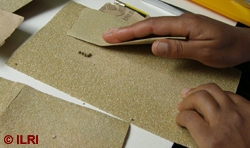 |
 |
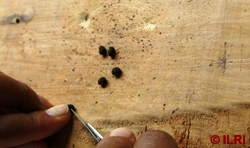 |
|
Sesbania bispinosa seeds ready to |
Medicago sativa seeds being scarified |
Rhynchosia sublobata seeds being scarified |
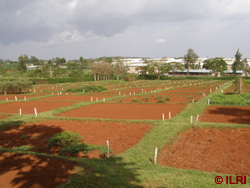
Regeneration fields for forage legumes in Soddo, Ethiopia (photo: ILRI) |
Field selection and preparation
Select the environment and soil type best suited for the species. Information on adaptation of species can be found from the Tropical Forage (http://www.tropicalforages.info/key/Forages/Media/Html/index.htm) and the FAO Grasslands Index (http://www.fao.org/ag/AGP/AGPC/doc/GBASE/mainmenu.htm) websites.
- Select the environment and soil type best suited for the species (see tables for herbaceous and fodder tree legumes).
- Select the field based on appropriate rotation and infection history to avoid mixtures and infection/infestation with different pests.
- Soil should have good drainage and be well prepared for sowing.
- Soil should be ploughed and disked, weeds and grasses removed. The soil should be prepared by tillage to obtain a well prepared and level seed bed prior to planting.
- Deep plough to invert soil, followed by harrowing two or three times, to produce a fine and an even flat seedbed.
- The majority of forage and pasture legume species are small seeded in size. The depth of planting should not exceed more than 3 cm.
Other precautions
- A population size of at least 100 plants should ideally be used for regeneration in order to maintain genetic variation.
Method of Regeneration
Planting layout, density and distance
- Aim for a final plant number of 100 in plots of approximately 25 m2 for outbreeders and 25 plants in plots of 10 m2 for vegetatve propagated grasses.
- Plant in 11 rows of 5 m long, each row 50 cm apart with within row spacing of 50 cm giving a density of 100 plants per plot. Smaller herbaceous plants can be planted closer together within the rows in smaller plots to avoid excessive weed growth on the large area of empty soil between plants.
- For accessions which are populations of genetically diverse material, such as landraces, it is recommended to plant 300 seeds in two rows, 2 m length.
- Fodder trees should be planted 1-2 m apart in larger plots or in rows.
- Forages vary in their breeding systems and species are planted at different isolation distances (see table or Species Compendium).
- Although many forages are in-breeding they often have low percentages of out-crossing and some species have limited information, therefore it is recommended to use an isolation distance of at least 100 m between accessions.
- Plant seeds of accessions of other species that do not hybridize or of other genera in between plots to increase the isolation distance.
- Bee-proof pollination cages are the best solution to isolate accessions and prevent insect pollination to avoid outcrossing but are expensive.
 |
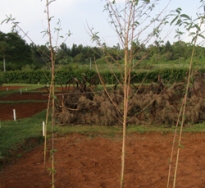 |
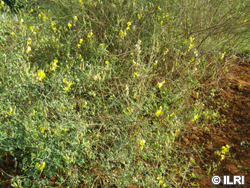 |
|
Herbaceous legumes and shrubs at ILRI are usually regenerated in 5x5 m plots (photos: ILRI) |
||
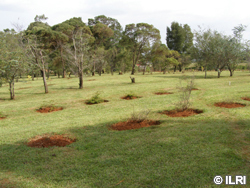 |
 |
_and_aulacocarp.jpg) |
|
Fodder trees at ILRI are usually regenerated in 25 m rows due to their larger size (photos: ILRI) |
||
Planting method
Direct sowing for large seeded species
- Count the number of seeds to be planted per row and place in separate envelopes/bags.
- Allow two seeds per hole if there are sufficient seeds because not all seeds will germinate. If there are few seeds, plant one seed per hole.
- Label the plot with the accession number and plot number as a minimum (taxonomic identification and origin of accession are also recommended).
- Lay out the plots at the chosen row spacing.
- Mark rows about the depth of the size of the seeds.
- Check that the accession number is correct and place one envelope/bag on the end of each row.
- Open the envelope and plant directly into a flat seedbed at a depth of 3 cm.
- Place two seeds per hole at 50 cm along the row by hand sowing for large seeds and spacing from 1 to 2 cm for smaller seeds.
- Cover with soil and lightly compact the soil in the row.
|
|
Seedling transfer for accessions with few seeds
- Germinate seeds in Petri dishes in an incubator. The conditions vary with species (see table for use in germination testing).
- As soon as the radicle start to emerge, plant the young seedlings individually in seedling trays or pots using sterilized compost or forest soil.
- Keep the pots away from direct sun but with good light intensity or in a greenhouse.
- Water carefully so the pots remain moist but not wet.
- Once seedlings are strong and growing well, place the pots outside for the seedlings to harden off for one week, watering carefully.
- Label the plot with the accession number, planting date and plot number. Taxonomic name and origin of accessions are also recommended.
- Peg out the plots at the chosen row spacing and make holes at 50 cm along the row.
- Transplant the seedlings carefully to the field, one seedling per hole, taking care not to damage the roots when the seedlings are transferred from the pots.
- Water after transplanting.
- Maintain few plants or weak seedlings in 8 inch pots for regeneration in the greenhouse.
Crop management
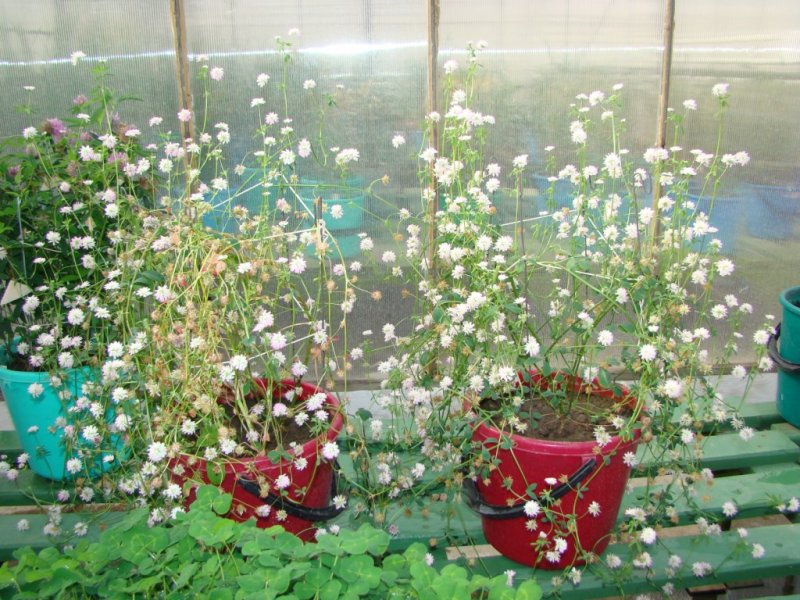 Trifolium growing in a winter greenhouse (Belarus genebank) (photo: Bioversity/ILRI by kind permission of Belarus genebank) 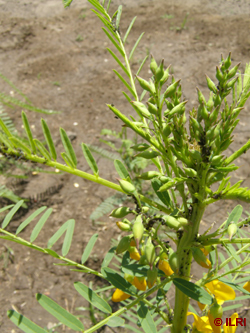 Aphids infestation in forage legumes (photo: ILRI)
Lablab purpureus pods with pod borer insect damage (photo: ILRI) |
Thinning
- If direct sown, thin to one plant per hole at 4-6 weeks after establishment when plants are growing well to keep plant density at about 100 plants per plot.
- Avoid competition that will result in weak plants and low seed yields.
- Avoid selecting only strong plants that would reduce genetic variation.
- Thinning can be done simultaneously with the first weeding.
Weed management
- Early growth can be slow and hand weeding four weeks after establishment is recommended.
- Cultivate between rows twice during early stages of plant growth.
- Eliminate plants growing off-row. Rogue plants that are genuine mixtures.
Irrigation
- Irrigate the field immediately after sowing and when needed subsequently.
- Do not allow the leaves to wilt at any stage.
- Ensure enough moisture in soil at the time of flowering.
Fertilization
- Although it is possible to grow the crop without fertilizer, it is recommended to apply Phosphorous at planting using DAP at 100 kg per ha.
- An additional application of 50-60 kg N per ha as a top dressing at early flowering stage will ensure good seed quality.
- Apply appropriate Rhizobium strains when needed.
Common pest and diseases
Forage legumes are susceptible to a wide range of virus and fungal diseases.
For updated and detailed information about pests and diseases on forage legumes see the STOGs section in this website.
Pest and disease control
- Coordinate periodic field inspections with pathologists and virologists during the growing season.
- Spray with appropriate chemicals when necessary. Spray with fungicide to control mildew during the rainy season or when using irrigation and with insecticide at the first sign of insect damage.
- Rogue out any infested material to eliminate all parasites before seed production and burn the residues.
Harvesting
-
Harvest by hand picking when the pods start to turn brown and begin to dry but before fully ripe pods start to dehisce and shatter.
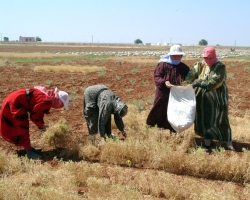
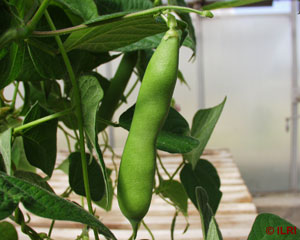
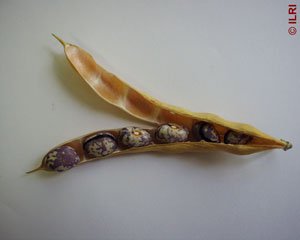
Manual harvesting (photo: ICARDA)
Green Phaseolus pod (photo: ILRI)
Mature Phaseolus bean seeds (photo: ILRI)
-
For non-dehiscent pods, cut the stems close to the ground and loosely roll the plant to allow final ripening and air drying before threshing to separate the seeds from the pods.
- Label all bags clearly with accession number, plot number and date of harvest on both the outside and on an inside label.
- Collect the pods from each plant in labeled cloth or paper bags with labels inside and outside each bag. Paper bags should only be used in dry climates.
- Harvest un-shattered and non-dropped pods by vacuum machine from large scale plots, otherwise by hand. The vacuum machine should be meticulously cleaned after harvesting each accession.
- Thresh the pods on a tarpaulin by gently beating or thresh small quantities by hand and return the seeds to their labeled bag.
-
Use appropriate methods for mechanical threshing:
- Medicago spp: A mechanical thresher designed specially for medics is used. In case of small quantities use hand rubber thresher.
- Trifolium spp: A hand rubber thresher is recommended to release the seeds from the fruiting heads.
- For all other species: A hand rubber thresher is recommended.
- Clean the seed thresher between each accession to ensure that seed mixing does not occur during threshing.
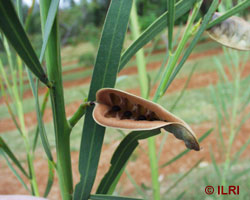 |
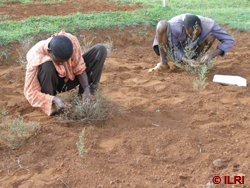 |
|
Dehiscent pod of Acacia suaveolens (photo: ILRI) |
Looking for mature seeds to harvest (photo: ILRI) |
Post-harvest management
- Clean the seeds of debris by hand picking, hand winnowing or using a seed blower.
- Hand pick over the seeds in trays to remove any shriveled, discolored, infected or damaged seeds from each plant. Incinerate the waste to avoid spread of seed borne diseases.
- In order to have equal replications of all individuals in a population take equal quantities of seeds from each plant and mix in one paper bag labeled inside and outside. Once you are sure you have all the seeds needed, the plants can be removed from the field or screen house.
- However, in practical terms for forages with indeterminate growth habit that are twining and climbing, individual plants cannot be easily distinguished in the plots. In these cases the best practice is to ensure the seeds are harvested from all parts of the plot thoroughly mixed and kept as a bulk sample.
- Retain the bags of each accession in temporary storage until seed drying.
- Take a sample of the seeds for seed health testing. If the fresh seeds are infected with seed borne pathogens and more original seeds are available for a second regeneration, destroy the seeds by incineration. If no original seeds are available, schedule the seeds for a further regeneration in controlled environmental conditions using agrochemicals to obtain clean seeds.
- If the seeds are free from pests and diseases, dry the seeds in low relative humidity at 15°C until they reach between 3-7% moisture content (see the seed drying page in this site for more details).
- Remove the seeds from the drying room, weigh and pack directly into storage containers. Options for containers for medium-term storage include using plastic containers or cans with sealed lids for storage in environments with humidity control or laminated aluminum foil packets for storage in environments without relative humidity control. Use of laminated aluminium foil packets is more suitable for long-term storage. Seal the containers or packets immediately.
- Sample and test the viability of the seeds and record the results following standard germination methods (ISTA, 2008). If viability is high, proceed to storage, if viability is low, reschedule the accession for a further regeneration from the original seeds.
- Store seeds in the genebank at 5-10°C in medium-term storage or at -18°C in long-term storage.
For more detailed information see the forage legume sample processing, viability and storage sections in this website.
Monitoring accession identity
Comparisons with previous passport or morphological data
- Distinctive traits are specific for each species. In general flower colour, flower parts, seed shape, colour and seed coat texture, number of leaf pinnae in compound leaves, pubescence and stem traits may be useful for comparison.
- Herbarium specimens are important to compare specimens to verify acession identity.
Documentation of information during regeneration
The following information should be collected during regeneration:
- Regeneration site name and map/GPS reference.
- Name of data collector.
- Field/plot/nursery/glasshouse reference.
- Accession number; population identification.
- Source of seed.
- Generation or previous multiplication or regeneration (if generation is not known).
- Preparation of planting materials (pre-treatments).
- Sowing date.
- Field layout and density used.
- Field management details (watering, fertilizer, weeding, pest and disease control, stresses recorded, others).
- Environmental conditions (altitude, precipitation, soil type, others).
- Emergence in the field or green house (number of plants germinated).
- Number of plants established.
- Pollination control method used.
- Harvest date and method.
- Days from sowing to flowering.
- Number of plants established and harvested.
- Quantity of seeds harvested/plant.
- Comparisons with reference materials (record any identification numbers or references of any samples or herbarium specimens taken from this regeneration plot).
- Agronomic evaluation; agro-morphological traits recorded.
- Taxonomic identification.
- Post harvest procedures.
References and further reading
Click here for a list of selected references on breeding systems in forage legume species.
Bray RA. 1983. Strategies for gene maintenance. In: McIvor JG, Bray RA, editors. Genetic Resources of Forage Plants. CSIRO, Melbourne, Australia. p157-168.
Dafni A, Firmage D. 2000. Pollen viability and longevity: practical, ecological and evolutionary implications. Plant Systematics and Evolution 222, 113–132.
Fairey DT, Hampton JG, editors. 1997. Forage Seed Production volume I:Temperate Species. CABI International, Cambridge, UK.
FAO/IPGRI. 1994. Genebank standards. Food and Agriculture Organization of the United Nations, Rome and International Plant Genetic Resources Institute, Rome. Available in English, Spanish, French and Arabic.
Friedman J, Barrett SCH, 2009. Wind of change: new insights on the ecology and evolution of pollination and mating in wind-pollinated plants. Annals of Botany 103, 1515-1527.
Hacker B, Hanson J. 1999. Crop growth and development: reproduction. In: Loch DS, Ferguson J, editors. Forage Seed Production vol II Tropical and Subtropical Species. CABI International, Cambridge, UK. pp. 93-111.
Humphreys LR, Riveros F. 1986. Tropical Pasture Seed Production. FAO Plant Production and Protection Paper 8, FAO, Rome, Italy. 203pp.
ISTA. 2008. International Rules for Seed Testing. International Seed Testing Association. ISTA secretariat, CH-Switzerland. Available from: www.seedtest.org/.
Loch DS, Ferguson J, editors. 1999. Forage Seed Production vol 2. Tropical and Subtropical Species. CABI Publishing, UK.
Neal PR, Anderson GJ. 2004. Does the `Old Bag' make a good `Wind Bag'?: Comparison of four fabrics commonly used as exclusion bags in studies of pollination and reproductive biology. Annals of Botany 93, 603-607.
Thormann I, Metz T, Engels JMM. 2004. The Species Compendium (release 1.0; December 2004). [online] Available from: http://www.bioversityinternational.org/databases/species_compendium_database/index.html. Date accessed 17 Jan 2011.
Comments
- No comments found





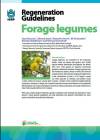
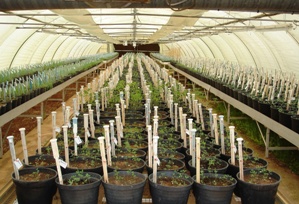

Leave your comments
Post comment as a guest